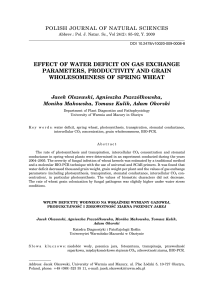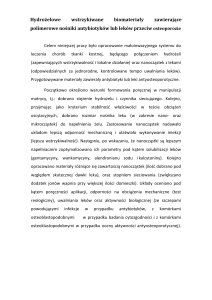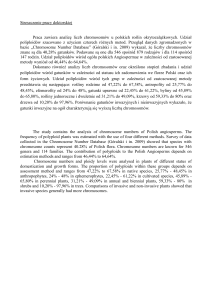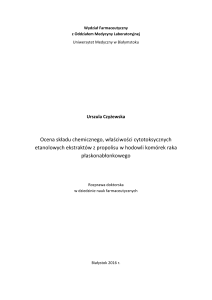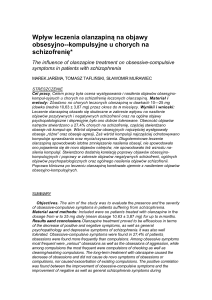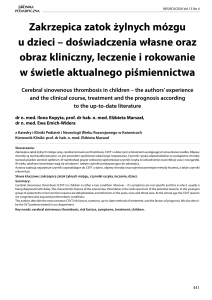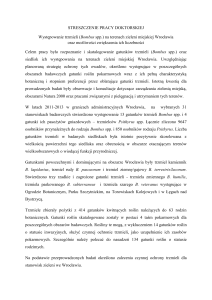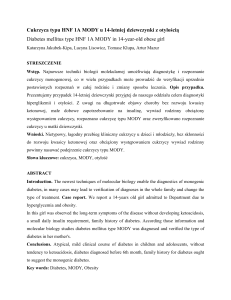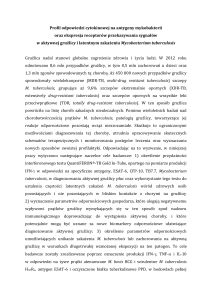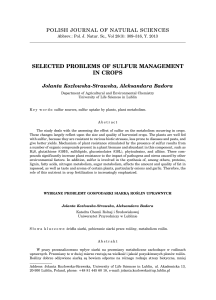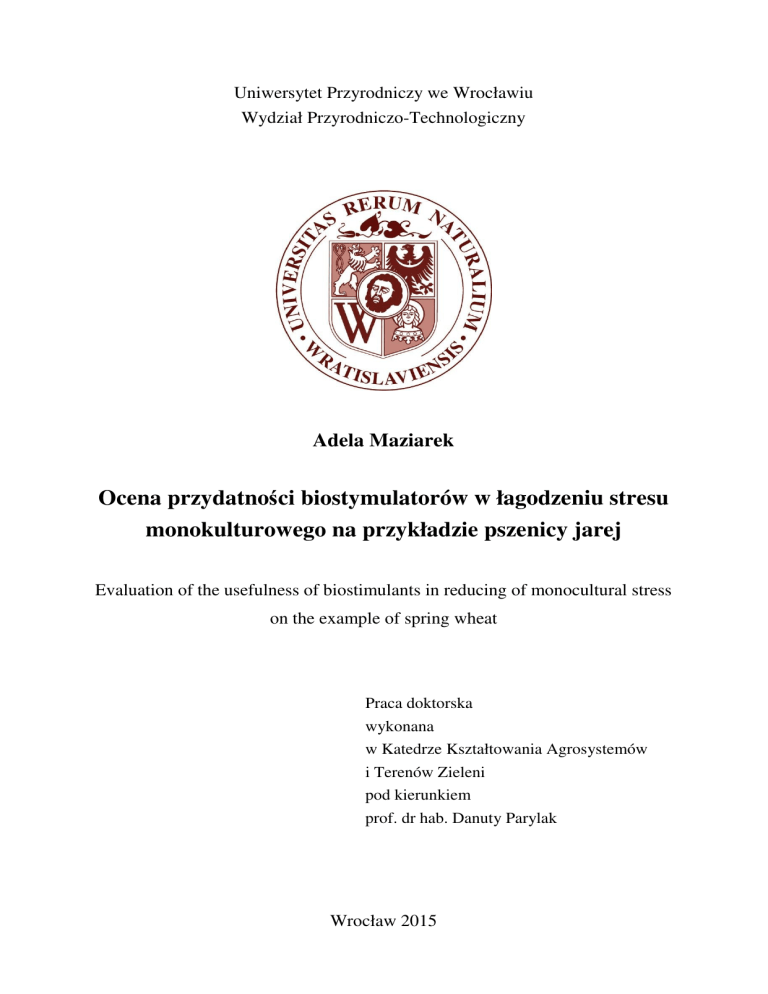
Uniwersytet Przyrodniczy we Wrocławiu
Wydział Przyrodniczo-Technologiczny
Adela Maziarek
Ocena przydatności biostymulatorów w łagodzeniu stresu
monokulturowego na przykładzie pszenicy jarej
Evaluation of the usefulness of biostimulants in reducing of monocultural stress
on the example of spring wheat
Praca doktorska
wykonana
w Katedrze Kształtowania Agrosystemów
i Terenów Zieleni
pod kierunkiem
prof. dr hab. Danuty Parylak
Wrocław 2015
STRESZCZENIE
Uwarunkowania ekonomiczno-organizacyjne zachęcają producentów do ograniczenia liczby
uprawianych gatunków w strukturze zasiewów. Prowadzi do uproszczeń zmianowań, a w skrajnym
wypadku do uprawy w monokulturze, szczególnie roślin zbożowych. Gatunkiem najbardziej
wrażliwym na uprawę po sobie jest pszenica. Skutkiem takich działań jest wzrost zachwaszczenia,
częstsze występowanie chorób podstawy źdźbła oraz naruszenie równowagi biologicznej i
chemicznej gleby, które najczęściej prowadzą do obniżki plonowania. Konieczne staje się więc
poszukiwanie metod, które pozwoliłyby na ograniczenie negatywnych skutków powtarzanej
uprawy zbóż. Cel ten można osiągnąć poprzez stosowanie biologicznych czynników
plonotwórczych (m.in. biopreparatów, międzyplonów ścierniskowych).
W hipotezie roboczej pracy założono, że zastosowanie zabiegów o charakterze regeneracyjnym
wpłynie na poprawę warunków wzrostu i rozwoju pszenicy jarej w krótkotrwałej monokulturze.
Celem badań było opracowanie nowoczesnych metod uprawy pszenicy jarej odmiany Monsun w
warunkach dużego udziału zbóż. Na polu doświadczalnym Opolskiego Ośrodka Doradztwa
Rolniczego w latach 2011–2013 prowadzono dwa ścisłe doświadczenia polowe. W doświadczeniu
jednoczynnikowym badano wpływ następstwa roślin (płodozmian, monokultura) na warunki
siedliskowe i roślinę uprawną. W doświadczeniu dwuczynnikowym oceniano wpływ coroczne
przyorywanego międzyplonu ścierniskowego z facelii błękitnej oraz biostymulatorów Nano-Gro,
Asahi SL, PRP EBV, Wuxal Ascofol na zmiany stanowiska oraz rozwój i plonowanie rośliny
uprawnej. Wyniki większości badań poddano analizie wariancji, a istotność różnic między średnimi
weryfikowano testem t-Studenta na poziomie 0,05.
Stwierdzono, że rezygnacja z płodozmianu na rzecz monokultury przyczyniła się do
negatywnych zmian w środowisku glebowym, w szczególności do zmniejszenia zwięzłości gleby i
wodoodporności agregatów glebowych. Uprawa pszenicy po sobie wpłynęła także na wzrost
zachwaszczeniu łanu i nasilenie występowania chorób podstawy źdźbła. Coroczne przyorywanie
międzyplonu ścierniskowego na ogół ograniczało, ale nie niwelowało skutków uprawy pszenicy
jarej bezpośrednio po sobie. Z kolei efektywność biostymulatorów w kształtowaniu warunków
siedliskowych i produkcyjnych pszenicy jarej uprawianej w monokulturze była niejednoznaczna i
zależała od rodzaju użytego biopreparatu.
Słowa kluczowe: pszenica jara, monokultura, biostymulatory, międzyplon ścierniskowy, plon
ABSTRACT
Economic and organizational conditions encourage producers to reduce the number of cultivated
species in crop structure. It leads to a simplification in crop rotation and in an extreme case especially for cereal seed - to a cultivation in monoculture. The most sensitive species to the
consecutive cultivation is wheat. The result of such actions is an increase of weeds, a higher
incidence of root rot diseases and a disturbance of biological and chemical balance of soil, which
most often lead to a decrease in yield. It isf, thus, necessary to search for methods that would allow
to reduce the negative effects of repeated crop production. This can be achieved through the use of
biological factors, yield components (including biologicals, stubble crop).
The working hypothesis of doctoral thesis assumed that the use of regenerative treatments would
improve the conditions for growth and development of spring wheat in the short-term monoculture.
The objective of this was to develop new methods of cultivation of spring wheat (Monsun variety)
with the increased share of crops. Two experiments were conducted on the experimental fields of
Agricultural Advisory Centre in Łosiów during the years 2011–2013. In the single-factor
experiment, the influence of plant succession (crop rotation, monoculture) on habitat conditions and
the crop was studied. In the double-factor experiment, the effect of the annual incorporation stubble
crop of Lacy Phacelia and biostimulants Nano-Gro, Asahi SL, PRP EBV, Wuxal Ascofol on the
change of their position, and the development and yield of the crop was determined. The results of
most investigations were subjected to the analysis of variance, and the significance of differences
between mean values was verified by Student t-test at 0.05 level of confidence.
It was found that the abandonment of rotation for monoculture contributed to the negative
changes in the soil environment, in particular to the reduction of soil compaction and water
resistance of soil aggregates. Wheat crop succession also influenced the growth of weed infestation
and severity of the diseases of the stem base. The annual stubble crop incorporation generally
limited the effects of the consecutive spring wheat cultivation but it did not reverse them. On the
other hand, the efficiency of biostimulants in shaping the habitat conditions and production of
spring wheat grown in monoculture was ambiguous and depended on the type of biologicals.
Key words: spring wheat, monoculture, biostimulants, stubble crop, yield

